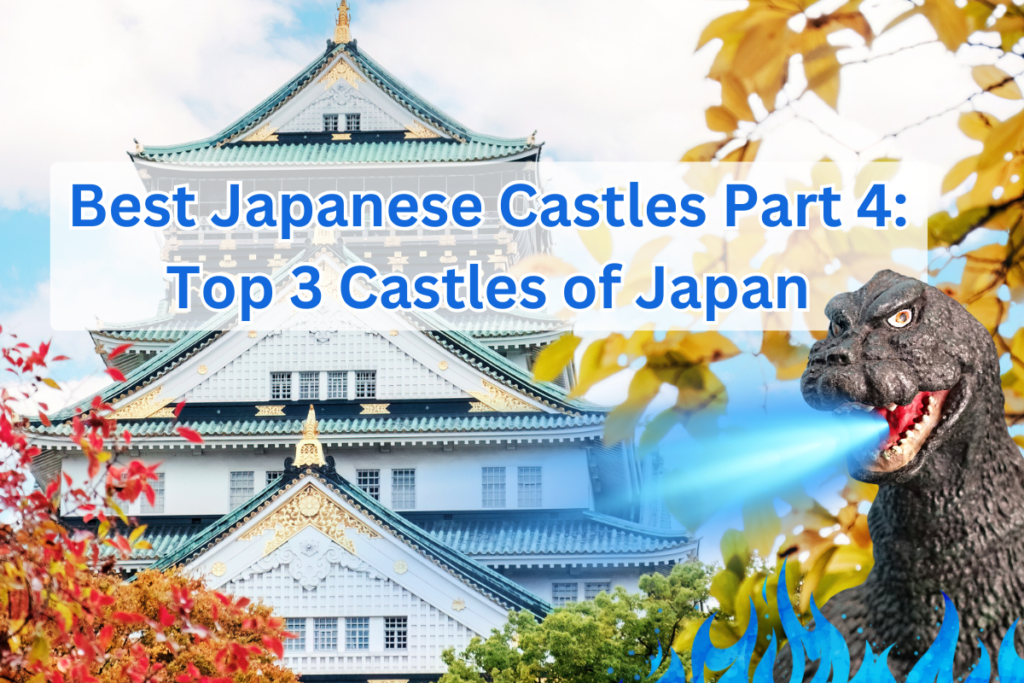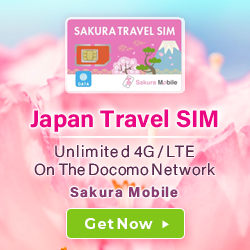Welcome back to our Best Japanese Castles series! As we introduced Nijo Castle and Himeji Castle last time, today we’ll introduce three more “premier castles” of Japan – Kumamoto Castle, Osaka Castle, and Nagoya Castle.
These three castles were ranked as 三名城 (sanmeijo), or the top 3 castles of Japan, by Ogyu Sorai in the Edo Period for their functionality and beauty. But, if you search “sanmeijo,” you’ll find that this is a contentious topic! Although there is no official top 3, let’s look closely at three significant castles chosen for their design.
We’ll also share some surprising trivia related to a giant green monster who can be found towering over Shinjuku on his off days. 🦖

Table of Contents
Best Japanese Castles Series Part 4: Top 3 Castles of Japan
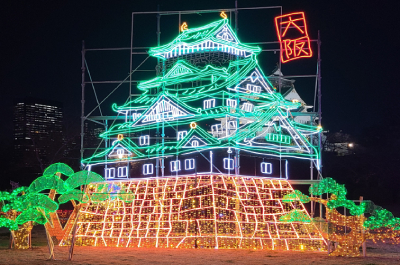
There are many castles in Japan, so deciding where to visit on your trip may be difficult. When researching Japanese castles, you might want to know the oldest, largest, or most beautiful. Beauty is in the eye of the beholder, so naturally, you’ll find various “top 3 castles” of Japan. One renowned Japanese scholar selected three castles from the Edo Period (1603-1868) based on their strategic design and beauty, and they remain popular tourist destinations today. Check out his list below and see if you agree with his top 3!
Who was Ogyu Sorai?
Ogyu Sorai (1666-1728) was an influential Confucian scholar and philosopher from Japan’s Edo Period. He recorded his list ranking the top three castles of Japan in “Kenroku Gaisho,” his book on military strategy. He considered Kiyomasa Kato and Todo Takatora master castle builders, and he made his list based on castle designers he admired. Now, let’s go over what Ogyu Sorai considered the best Japanese castles.
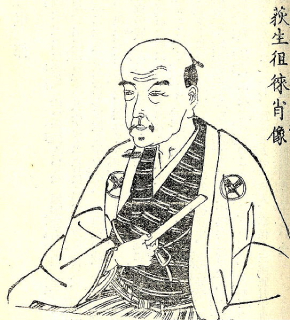
1. Kumamoto Castle (熊本城)
Basic information:
- Location – Honmaru, Chuo Ward, Kumamoto City, Kumamoto Prefecture
- Opening Hours – 9:00-17:00 (Last admission 16:30)
- Admission Fee – Main entrance fee: 800 yen (high school student+)
Joint admission ticket: 850 yen to access to Wakuwaku-za/Castle Museum (interactive exhibit hall) - Access – Take the tram from JR Kumamoto Station (17 min. ride) and get off at Kumamotojo-mae.
- Translation – The Kumamoto Castle App provides audio guides and translations in English, Korean, and Chinese.
- Official Site – https://castle.kumamoto-guide.jp/en/
* The castle is still undergoing renovations, but you can see the main castle keep and other areas renovated as of 2021!
First, let’s explore Kumamoto Castle. As we covered the types of castles in Part 1, you may be familiar with 平山城 (hirayamajiro), a castle built on a hill overlooking a plain. Kumamoto Castle is this type!
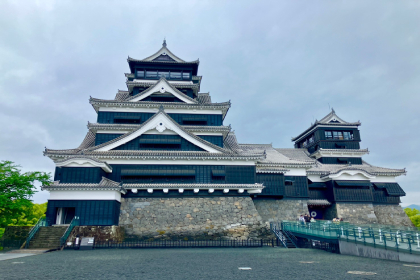
🏯Before your trip, don’t forget your SIM card!
Get our Sakura Mobile e-SIM/SIM card to make it easy for you to post photogenic scenes like the top 3 castles of Japan! You can also check the latest visiting information for the castles on your trip.
Get an e-SIM/SIM card or Pocket WiFi to make traveling easier!
History
The foundations for Kumamoto Castle were first laid in 1467. Later, the first feudal lord of Kumamoto and the mastermind behind the castle’s expansion, Kiyomasa Kato, began construction in 1601 and finished in 1607. His strategic design plan would go on to inspire other Japanese castle builders.
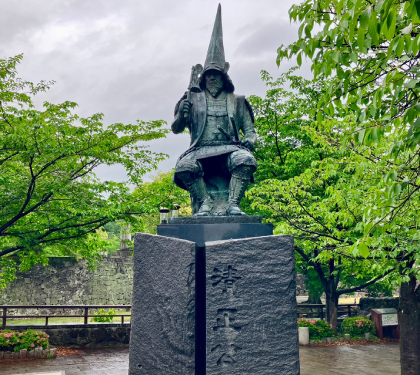
During the struggle for power between the samurai and the Meiji government in the Satsuma Rebellion, the castle was besieged, and the main castle keep and other areas were burned down in 1877. It has undergone various restoration work, beginning in 1960 and continuing in more recent years after the 2016 Kumamoto Earthquakes.
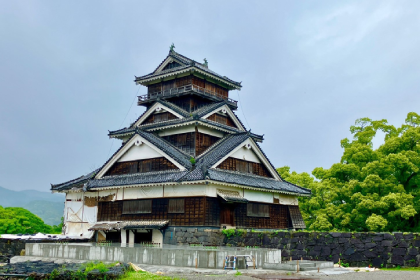
Inside the Castle Grounds
A modernized castle, the main castle keep even has AC, which is a godsend in sweltering Japanese summers. There are also elevators, making it very accessible for wheelchairs or parents with strollers. You can see a view of Kumamoto City from the 6th floor of the Tenshukaku, the main castle keep.
While exploring the castle, you will find many defensive features, such as windows for dropping boulders on intruders. There is also a restored underground pathway known as “Kuragari-tsuro,” or “the Dark Passage,” built underneath the palace, Honmaru-Goten. It’s dimly lit, so you can feel like you’re sneaking around a secret passage!
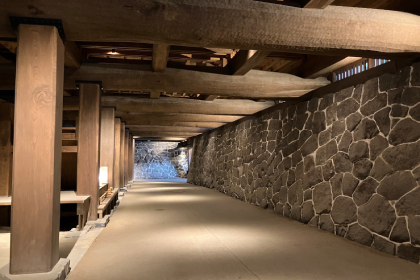
What makes Kumamoto Castle unique?
One of the first things you will notice about the castle’s stone walls is how steep they are towards the top. These walls were nicknamed “musha-gaeshi” or warrior-repellant walls that even ninjas couldn’t climb! After the 2016 earthquakes, many of the original stone walls survived, which has led some to speculate if Kiyomasa Kato also considered earthquake resistance in their design.
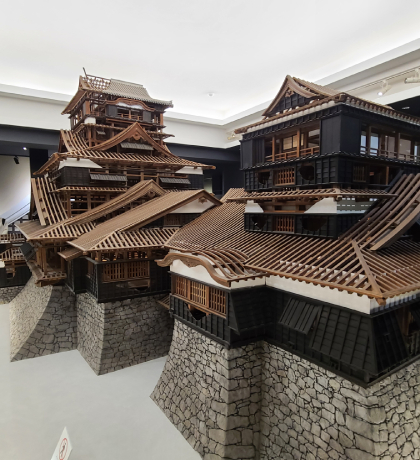
↑ Go back to the table of contents
2. Osaka Castle (大阪城)
Basic information:
- Location – Chuo Ward, Osaka City, Osaka Prefecture
- Opening Hours – 9:00-17:00 (Last admission 16:30)
Closed: 12/28-1/1 - Admission Fee – Main entrance fee is 600 yen (high school student+). Free for children 15 or younger.
- Access – Take the JR Osaka Loop Line. Easiest access from Morinomiya or Osakajokoen Station.
- Translation – Leaflets are available in English, Korean, and Chinese. Some exhibits have explanations in English. Audio guide devices are available for free rental (Japanese, English, Korean, Chinese).
- Official Site – https://www.osakacastle.net/
Next, let’s look at Osaka Castle, a flat mountain castle (平山城/hirayamajiro) that is a must-see spot for tourists in Osaka!
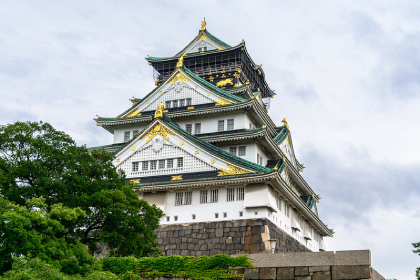
History
Osaka Castle began construction in 1583 under the feudal lord Toyotomi Hideyoshi, a famous historical figure known for his efforts towards unifying Japan after the Warring States Period (1467-1567). Like many other castles in Japan, it has been rebuilt over the years. The original castle was destroyed in a battle called “Osaka Natsu no Jin,” or the Seige of Osaka Castle (1615). You can see an exhibit depicting this battle on the 5th floor of the main keep.
The Tokugawa shogunate began rebuilding Osaka Castle in 1620 on top of the old ruins. The main tower that we know today was reconstructed with concrete in 1931 and the most recent renovation was completed in 1997.
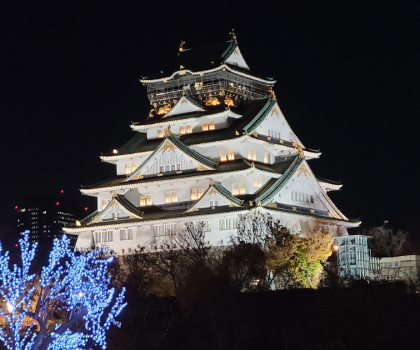
Inside the Castle Grounds
Up to 1 million large stones are estimated to have been used in Osaka Castle’s massive stone walls. Try to find the tako-ishi (octopus stone), which is said to be the largest castle stone in Japan! Another impressive defense measure is the castle’s moat, which has walls up to 20 meters tall and 90 meters wide.
Inside the Tenshukaku, the main castle keep, you’ll find a museum with artifacts and information about the Toyotomi clan. Looking for a view of the city? Go up to the 8th-floor observation deck (wheelchair accessible!) for a 360-degree view of the city and surroundings!
If you visit in the spring, make sure to stroll through Nishinomaru Garden, known for its 600 cherry trees. It’s a popular spot for hanami (cherry blossom viewing), and you can take a great photo with sakura and Osaka Castle! In winter, you can look forward to the “Osaka Castle Illuminage,” where you can enjoy illuminations spread throughout the garden!
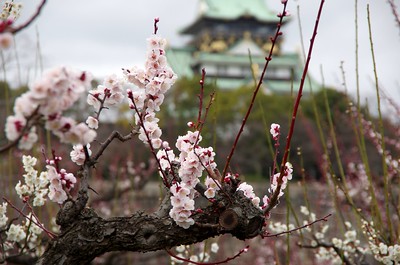
What makes Osaka Castle unique?
Osaka Castle is also known for its beautiful decorations, including the shachihoko (鯱), golden fish with dragon/tiger heads, on the roof. These mythical creatures were placed on castle roofs in hopes that they would put out fires. It is said that Hideyoshi loved gold, and Osaka Castle is also known as Kinjo (錦城 or 金城), which translates to “golden castle.” Try taking a picture of Osaka Castle’s gold leaf embellishments shining in the sun! Be sure to visit what some people say is one of the best Japanese castles!
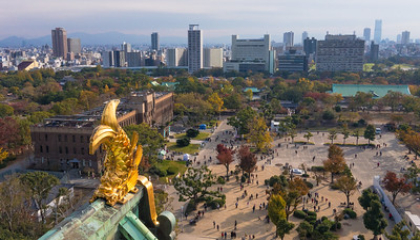
Before you leave, check out a takoyaki restaurant nearby where you can buy ice cream with edible gold leaf!
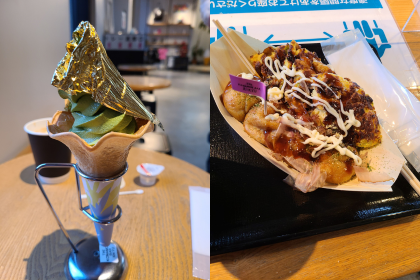
↑ Go back to the table of contents
3. Nagoya Castle (名古屋城)
Basic information:
- Location – Honmaru, Naka Ward, Nagoya City, Aichi Prefecture
- Opening Hours – 9:00-16:30 (Admission until 16:00)
Closed: December 29 – January 1 - Admission Fee – Adult: 500 yen, free for junior high and below.
- Access – Walk 25 min. from Nagoya Station or take the subway to Shiyakusho Station.
- Translation – Free English-speaking tours by Aichi Goodwill Guides Network (AGGN).
- Official Site – https://www.nagoyajo.city.nagoya.jp/en/
*Interior access to the main tower is currently restricted.
Finally, let’s explore a flat plain castle (平城/hirajiro), Nagoya Castle!
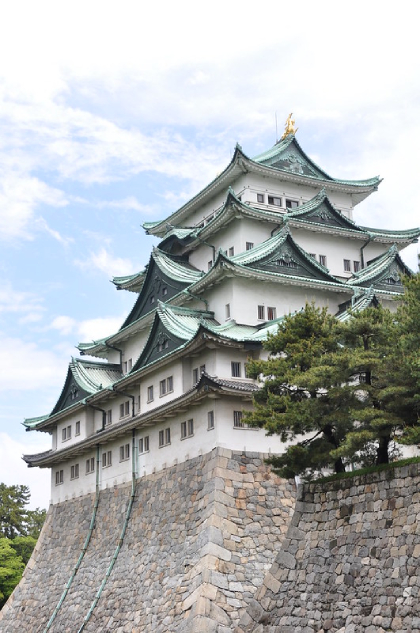
History
Construction began for Nagoya Castle in 1610 under Tokugawa Ieyasu, the first shogun of the Tokugawa shogunate. Although he succeeded in unifying Japan, Tokugawa was still wary of his enemies near Osaka, so he built the castle as a residence for his son, Yoshinao, who he put in charge of the region.
Contrary to the shogun’s fears, the castle was never attacked, and arts such as tea ceremony and ceramics flourished in the region. Thanks to its strategic location, Nagoya became one of the most prosperous cities in the Edo Period.
The castle was destroyed by firebombing in World War II, but it was reconstructed using concrete in 1959.
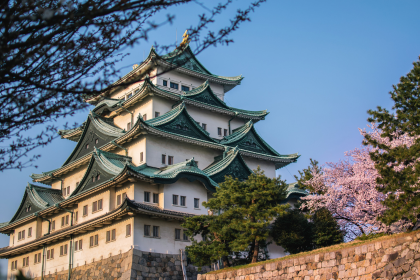
Inside the Castle Grounds
The highlight of Nagoya Castle is its reconstructed Honmaru Palace. It is made entirely out of wood and faithfully reproduced using traditional methods. Visitors can admire the golden murals, traditional Japanese paintings, and ornate carvings. If you are a fan of traditional Japanese art, this is a must-see!
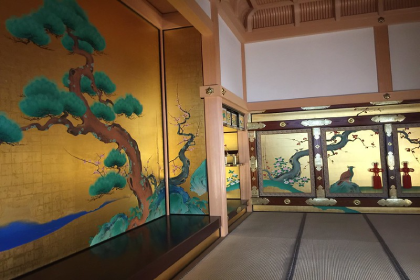
The surrounding Ninomaru Garden was the largest garden connected to any lord’s residence at that time. It is a beautiful Japanese-style garden that still delights visitors today. As you stroll the gardens, you’ll also see many tea houses in the rear “Ofuke-maru” area. Stop by Ninomaru Tea House for green tea and Japanese sweets in a beautiful setting!
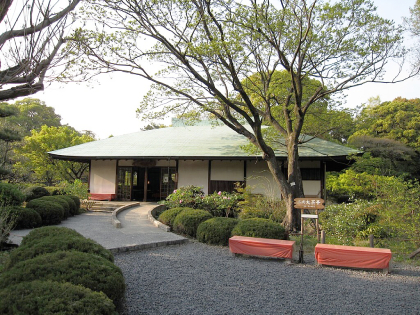
Remarkably, all three corner watch towers survived the fires, and you can see the original Southwest Corner Tower with its ishi-otoshi, or slots to drop stones. You can also search for the biggest stone used for the defensive walls, named after one of the castle architects who brought it ー the famed Kiyomasa Kato.
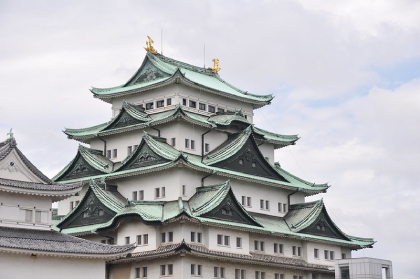
What makes Nagoya Castle unique?
On the roof are two shachihoko, but Nagoya Castle’s are known as “kinshachi,” since they are plated in 18-karat gold! Each kinshachi is over 2 meters tall and weighs over 1,200 kilograms. They have become a famous symbol of Nagoya.
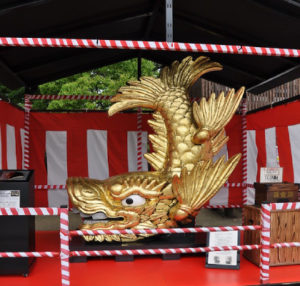
Many castles in Japan have been rebuilt using more modern methods, but plans are underway to tear down the concrete replica of Nagoya Castle and rebuild the main castle using traditional methods and wooden materials.
↑ Go back to the table of contents
Conclusion
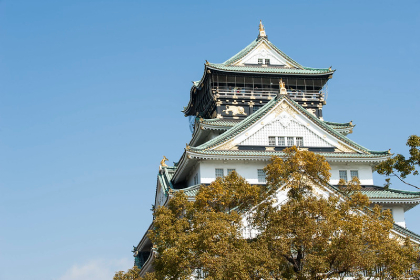
Did this list surprise you? After learning about the top 3 castles in Japan, try visiting a few castles and making your own list! No matter which part of Japan you travel to, make visiting a castle a part of your trip! Japanese castles are not only important historical and cultural sites, but they also offer scenic views of the city and are a great photo spot for any traveler. Take time out of your trip to visit some of the best Japanese castles while exploring the country!
Related Articles
If you haven’t read our “Best Japanese Castles” series, check them out!
Read more about how Sakura Mobile can keep you connected with your friends/family back home below!👀
↑ Go back to the table of contents
Get an e-SIM/SIM card or Pocket WiFi to make traveling easier!
Having internet data can be helpful when planning your day, contacting your friends, and killing time. If you need a SIM card or a pocket WiFi, we recommend Sakura Mobile! We offer excellent services such as delivery to your hotels, unlimited data options, full English support, and more! In addition, you can pick up your SIM card or pocket WiFi directly upon arriving at our counter at Narita, Haneda, or Kansai International Airport.
Here are some features of Sakura Mobile:
・Unlimited data options for SIM cards
・Portable Wi-Fi you can easily return
・Full English support
・Stable internet network
By reserving online before departing, you can
-
-
- Lower your rental fees
- Avoid stock shortages at the airport
- Start your trip with internet data
-
To learn more about data and WiFi options for your trip, check out our products below.

